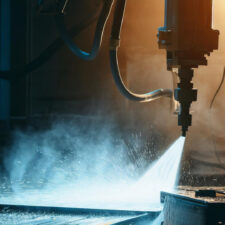Waterjet cutting is a versatile technology that has gained popularity in recent years due to its precision, speed, and ability to cut a wide range of materials. It is a non-thermal cutting process that uses a high-pressure jet of water or a mixture of water and abrasive to cut through materials such as metal, stone, glass, ceramic, and composites. In this article, we will explore the benefits, applications, and limitations of waterjet cutting.
Benefits of Waterjet Cutting
- Precision: Waterjet cutting is a highly precise cutting method that can achieve tolerances of up to +/- 0.003 inches. This precision makes it ideal for cutting intricate shapes and designs with high accuracy.
- Speed: Waterjet cutting is a fast cutting method that can cut through materials at speeds of up to 600 inches per minute. This speed makes it ideal for large production runs and time-sensitive projects.
- Versatility: Waterjet cutting can cut through a wide range of materials, including metal, stone, glass, ceramic, and composites. This versatility makes it an attractive option for industries such as aerospace, automotive, and architecture.
- No Heat-Affected Zone (HAZ): Waterjet cutting is a non-thermal cutting method, meaning that it does not generate heat during the cutting process. This lack of heat minimizes the risk of material distortion, warping, or melting. It is an ideal solution for materials that are sensitive to heat, such as plastics or composites.
- Environmentally Friendly: Waterjet cutting is an environmentally friendly cutting method that does not generate hazardous waste or emit harmful gases. The water used in the cutting process can be recycled and reused, making it an eco-conscious choice for businesses.
Applications of Waterjet Cutting
Waterjet cutting has a wide range of applications across different industries. Some of the most common applications of waterjet cutting include:
- Aerospace: Waterjet cutting is used in the aerospace industry to cut parts for airplanes, rockets, and satellites. It is particularly useful in cutting titanium, aluminum, and composites, which are commonly used in aerospace applications.
- Automotive: Waterjet cutting is used in the automotive industry to cut parts for cars, trucks, and other vehicles. It is particularly useful in cutting metal parts such as gears, brackets, and suspension components.
- Architecture: Waterjet cutting is used in the architecture industry to cut decorative features, such as balustrades, columns, and staircases. It is particularly useful in cutting stone and glass, which can be difficult to cut using traditional methods.
- Manufacturing: Waterjet cutting is used in the manufacturing industry to cut parts for machinery, equipment, and tools. It is particularly useful in cutting materials such as steel, aluminum, and composite materials.
Limitations of Waterjet Cutting
As with any cutting method, waterjet cutting has some limitations that should be considered. Some of the limitations of waterjet cutting include:
- Thickness: Waterjet cutting is suitable for cutting materials up to 6 inches thick. Materials thicker than 6 inches may require multiple passes, which can increase the production time and cost.
- Size: The size of the material that can be cut using waterjet is limited by the size of the cutting bed. Large materials may need to be cut in sections, which can increase the production time and cost.
- Cost: Waterjet cutting is a relatively expensive cutting method compared to other cutting methods such as laser cutting or plasma cutting. The cost of the equipment and the abrasive material used in the cutting process can be high.
Conclusion
Waterjet cutting is a versatile technology that offers many benefits, including precision, speed, versatility, and eco-friendliness. It has a wide range of applications across different industries, including aerospace, automotive, architecture, and manufacturing. While it has some limitations, such as thickness and cost, waterjet cutting remains a popular choice for businesses looking for a precise and versatile cutting method.

